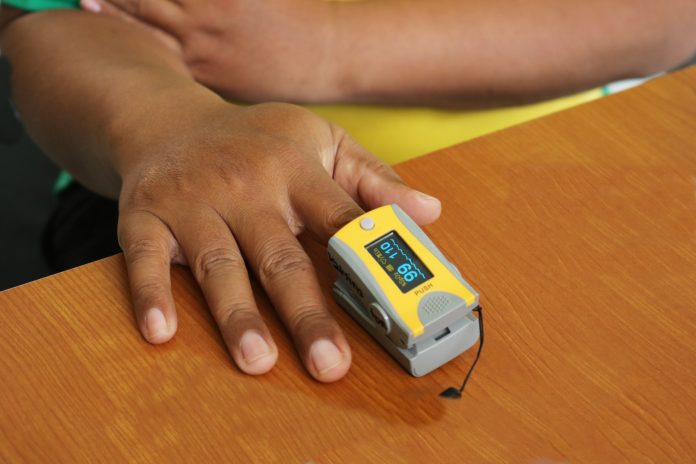
By
As the Black community grapples with the ongoing impact of COVID-19, research shows that the faultiness of pulse oximeters on dark-skinned people contributed to poor outcomes during the pandemic.
When clipped onto a patient’s finger, pulse oximeters send a beam of light through the skin to calculate oxygen levels.
Most times, the technology works correctly on lighter skin, but for dark-skinned folks, the oxygen levels could read inaccurately high.
When this happens, a person could appear to have more oxygen in their body than they actually do, resulting in misdiagnosis or undertreatment of COVID-19 and other illnesses.
As scientific evidence continues to reveal more about the issue, medical professionals are getting vocal about the dangers of using pulse oximeters on Black people — including Joel Bervell, a 27-year-old medical student whose Tik Tok video about the device’s inconsistencies went viral in 2020.
“Every single time you go to the hospital, you’re going to get a pulse oximeter. It’s something that’s so ubiquitous, yet can go so wrong,” Bervell told Word In Black in a phone interview.
Pulse Oximeters Caused Delayed COVID-19 Treatment for Black Folks
A study published in JAMA Internal Medicine in July found that pulse oximeters read oxygen levels for Black, Asian, and Hispanic patients in intensive care units at higher levels than white patients.
As a result, the patients of color received less supplemental oxygen — which helps people cope with COVID-19, sleep apnea, and other breathing problems.
Bervell says this is “scary to think about” because some folks who needed more oxygen may have been sent home without it.
“If you’re someone who’s gone to the hospital for shortness of breath — especially with COVID — you go to the hospital, you’re hoping to get treated, hoping to get maybe some additional oxygen. You’re saying you’re not feeling well, but this device is saying something entirely different,” he says.
Bervell says until the devices are reading more accurately, it’s going to take exploring the “art side of medicine” to be sure patients are cared for equally.
The inaccurate result could have sent people home earlier than medically necessary. Maybe they should have actually stayed in the hospital, Bervell says, but instead doctors said, “actually, your oxygen saturation was fine, let’s send you home.”

To his point, another study published in May found that treatment for COVID-19 was delayed for Black and Hispanic patients due to the devices’ inaccurate readings.
The research concluded that the patients of color had lower levels of oxygen in their blood than the oximeters calculated.
“This disparity may contribute to worse outcomes among Black and Hispanic patients with COVID-19,” the authors wrote.
Unfortunately, these findings come after the virus ravaged the Black community, doing disproportionate damage.
Since the pandemic started, about 97.9 out of every 100,000 Black persons have died from COVID-19. This is over two times the death rate of white people, who die at about 46.6 per every 100,000.
And of those who survived, many are still recovering.
The Federal Government’s Response
In 2013, the Food and Drug Administration (FDA) recommended that pulse oximeter manufacturers include a range of skin tones in their studies, “including at least 2 darkly pigmented subjects, or 15% of your subject pool, whichever is larger.”
But these recommendations are not legally binding.
Now, in the wake of outcry about the issue, the agency hosted a virtual public meeting in November through the CDRH Anesthesiology and Respiratory Therapy Devices Panel of the Medical Devices Advisory Committee, where speakers shared concerns about the device and its impact on darker-skinned people.
The FDA is currently reviewing the committee’s recommendations before taking any additional action.
Bervell says coming out of that meeting, “there’s a lot of hope that there’s going to be some changes made.”
Pulse oximeters remain on the market in the meantime — including prescription oximeters, which are reviewed by the FDA and mostly used in health care settings, and over-the-counter (OTC) oximeters.
The FDA advises against using OTC oximeters for medical purposes.
Bervell says until the devices are reading more accurately, it’s going to take exploring the “art side of medicine” to be sure patients are cared for equally.
“The art side is really using all those context clues to figure out how we best help a patient,” he says.
Fortunately, pulse oximeters aren’t the only way to read a person’s oxygen levels. Though, they might be the least painful.
An arterial blood gas test is another option. During the procedure, a physician inserts a needle into the patient’s body and draws blood from an artery.
Bervell says “it’s not as fun, but sometimes, if it’s really important, maybe that is what you have to do to make sure we get there.”
An aspiring pediatric orthopedic surgeon studying at Washington State University, Bervell continues to produce his “Racial Bias in Medicine” series that brought the issue of pulse oximeters to light on social media.
“I think there’s a power right now in using social media to discuss these types of conversations. Traditional media has often left out these narratives, as well as medical school, not often talking about this.”


